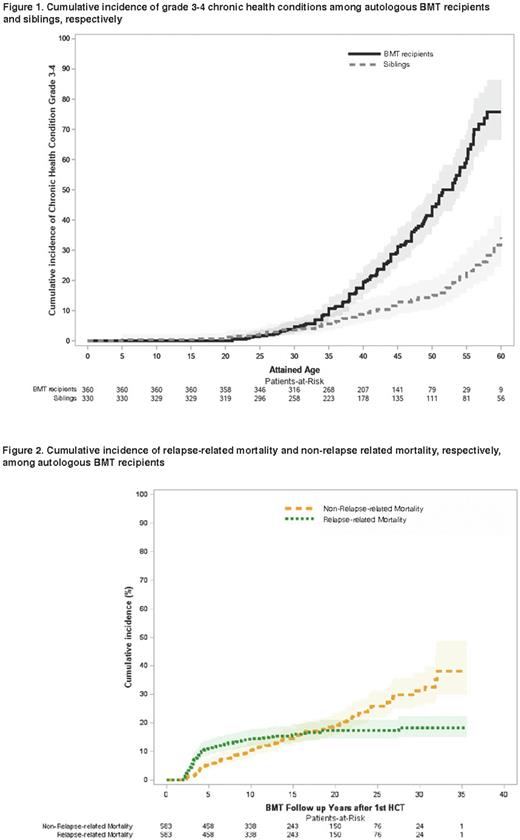Abstract

Introduction: Autologous BMT is an integral part of consolidation and/or salvage therapy for children, adolescents and young adults with Hodgkin lymphoma (HL) and non-Hodgkin lymphoma (NHL). However, there is paucity of information regarding the long-term outcome after autologous BMT for lymphoma performed in this age group. We address this gap by leveraging the BMTSS to determine the magnitude of risk of chronic health conditions as well as cause-specific late mortality in patients undergoing autologous BMT for lymphoma between 1980 and 2014 at City of Hope, University of Minnesota or University of Alabama at Birmingham.
Methods: To be included in this analysis, patients had to have received a single or tandem autologous BMT before age 40y and survived ≥2y after transplantation. BMT recipients (n=583 [HL: 59.7%; NHL: 40.3%]) and a sibling comparison group (n=330) completed a 255-item survey, and self-reported sociodemographics and chronic health conditions. A severity score (grade 3 [severe], 4 [life threatening] or 5 [fatal]) was assigned to the conditions using CTCAE v5.0. Vital status and cause of death information was ascertained using the National Death Index (NDI), medical records and Accurint databases. Logistic regression estimated the odds of grade 3-4 conditions in BMT recipients alive at study participation compared to siblings. Fine-Gray regression estimated the hazard of grades 3-5 chronic health conditions among BMT recipients (alive and deceased), treating death as a competing risk.
Results: Median age at BMT was 30.0y (range: 2.0-39.0); median length of follow-up was 9.6y (2.0-32.1) and median age at study participation was 41.1y (13.7-67.1). Severe/life-threatening chronic health conditions in BMT survivors compared with siblings: By age 45y, the cumulative incidence of a grade 3-4 chronic health condition was 31.2% (95%CI; 25.5-37.0) among the BMT survivors and 12.9% (95%CI; 8.8-17.7) among the siblings (p<0.0001) (Figure 1). BMT survivors were at a 3.2-fold greater odds of a grade 3-4 condition (aOR=3.2, 95%CI=2.2-4.8) compared to siblings. Greater odds were observed among BMT survivors vs. siblings for the following conditions: joint replacement (OR=4.9, 95%CI=1.7-13.7), cataract (OR=4.2; 95%CI=1.4-13.0), cardiovascular disease (OR=2.2, 95%CI=1.2-4.0), and multiple conditions (OR=4.9; 95%CI=2.6-9.5). Severe/life-threatening/fatal chronic health conditions among BMT recipients: The 20y cumulative incidence of grade 3-5 conditions for the entire cohort was 46.8% (95%CI=41.6-51.7%). The 20y cumulative incidence was 42.1% (95%CI=34.2-49.7%) for patients with NHL and 49.6% (95%CI=42.9-56.0%) for patients with HL, placing HL patients at a 1.4-fold higher adjusted hazard of grade 3-5 conditions (95%CI=1.0-1.8, p=0.0232). Late mortality in BMT survivors: Conditional on surviving the first 2y after BMT, the all-cause mortality rate was 54.3% (95%CI=48.8-59.4%) at 25y from BMT (HL: 62.6%; NHL: 42.3%). The adjusted hazards of all-cause mortality were higher in HL patients (HR=1.8, 95%CI, 1.3-2.4; reference: NHL), and among Black patients (HR=3.0, 95%CI, 1.9-4.6; reference: non-Hispanic white). Causes of death were available for 84% of the cohort, and included primary disease (35%), subsequent neoplasm (16%), infection (13%), cardiac disease (8%), pulmonary disease (3%), and homicide/suicide/accident (3%). As shown in Figure 2, relapse-related mortality (RRM) plateaued after 20y from BMT, whereas the non-relapse-related mortality (NRM) continued to climb, crossing RRM at 20y from BMT. The 25y cumulative incidence of RRM was 28% (95%CI=22-34%), while that for NRM was 37% (95%CI=31-44%). Patients with HL were at increased risk for RRM (HR=2.3, 95%CI=1.3-3.8, p=0.0029; reference: NHL). The hazard of NRM was greater among HL patients (HR=1.7, 95%CI=1.1-2.7), and Black patients (HR=3.1, 1.5-6.4; reference: non-Hispanic white).
Conclusions: The burden of severe/life-threatening chronic health conditions was 3-fold higher in autologous BMT recipients for lymphoma when compared with a non-BMT sibling comparison group. Patients with HL were at increased risk of a severe/life-threatening/fatal conditions as well as late mortality, when compared to patients with NHL. Finally, Black patients were at a higher risk for non-relapse-related mortality. These findings suggest a need for long-term surveillance among the vulnerable sub-populations.
Disclosures
Landier:Merck Sharp & Dohme: Other: Wendy Landier's institution has received vaccine supply and laboratory services for an unrelated clinical trial through the Investigator Initiated Studies Program of Merck Sharp & Dohme (MISP #40083). Weisdorf:FATE Therapeutics: Other: Research Support; Incyte: Other: Research support.
Author notes
 This icon denotes a clinically relevant abstract
This icon denotes a clinically relevant abstract
Asterisk with author names denotes non-ASH members.


This feature is available to Subscribers Only
Sign In or Create an Account Close Modal